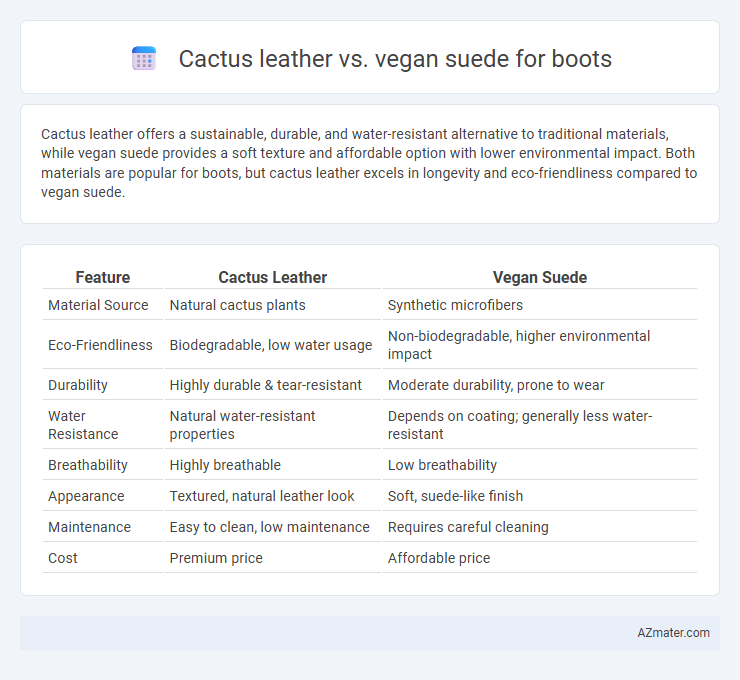Cactus leather offers a sustainable, durable, and water-resistant alternative to traditional materials, while vegan suede provides a soft texture and affordable option with lower environmental impact. Both materials are popular for boots, but cactus leather excels in longevity and eco-friendliness compared to vegan suede.
Table of Comparison
| Feature | Cactus Leather | Vegan Suede |
|---|---|---|
| Material Source | Natural cactus plants | Synthetic microfibers |
| Eco-Friendliness | Biodegradable, low water usage | Non-biodegradable, higher environmental impact |
| Durability | Highly durable & tear-resistant | Moderate durability, prone to wear |
| Water Resistance | Natural water-resistant properties | Depends on coating; generally less water-resistant |
| Breathability | Highly breathable | Low breathability |
| Appearance | Textured, natural leather look | Soft, suede-like finish |
| Maintenance | Easy to clean, low maintenance | Requires careful cleaning |
| Cost | Premium price | Affordable price |
Introduction to Sustainable Boot Materials
Cactus leather, derived from the mature leaves of the Nopal cactus, offers a biodegradable and water-efficient alternative to traditional leather, making it a sustainable choice for boot production. Vegan suede, typically made from microfiber or recycled polyester, provides an animal-friendly and durable option that mimics the softness and texture of real suede without the environmental impact of animal farming. Both materials contribute to reducing carbon footprints and resource consumption in sustainable footwear manufacturing.
What is Cactus Leather?
Cactus leather is an innovative, sustainable material made from the mature leaves of the nopal cactus, offering a durable and eco-friendly alternative to traditional leather. It features a natural fibrous texture that mimics animal leather while using significantly less water and producing fewer greenhouse gases compared to vegan suede, which is typically made from synthetic fibers like polyurethane. This plant-based leather is biodegradable and free from harmful chemicals, making it an ideal choice for environmentally conscious boot manufacturing.
What is Vegan Suede?
Vegan suede is a synthetic alternative to traditional suede made from animal hides, crafted using microfibers or plant-based materials like recycled polyester or polyurethane, designed to mimic the soft, velvety texture of genuine suede. Unlike cactus leather, which is derived from the mature leaves of the nopal cactus and offers a sustainable, biodegradable option, vegan suede typically involves chemicals and plastic components with varying environmental impacts. Boots made from vegan suede provide cruelty-free fashion with a focus on durability and affordability, though they may lack the breathability and eco-friendliness associated with plant-based leathers.
Environmental Impact Comparison
Cactus leather, derived from sustainable nopal cactus, offers a biodegradable and water-efficient alternative to traditional materials, significantly reducing carbon emissions compared to synthetic leather production. Vegan suede, typically made from polyester or polyurethane, relies on petrochemical processes that generate higher greenhouse gas emissions and contribute to microplastic pollution. Choosing cactus leather for boots minimizes environmental impact through renewable resource use and lower ecological footprint.
Durability and Longevity
Cactus leather offers higher durability and longevity compared to vegan suede, thanks to its natural fiber structure that resists wear and tear over time. Vegan suede, typically made from polyurethane or microfiber, tends to show signs of abrasion and color fading faster under regular use. Boots crafted from cactus leather maintain their strength and appearance longer, making them a more sustainable and resilient choice for extended wear.
Comfort and Wearability
Cactus leather offers superior breathability and flexibility compared to vegan suede, enhancing comfort during extended wear in boots. Its natural moisture-wicking properties reduce heat buildup and foot perspiration, while vegan suede can sometimes feel less breathable and more prone to heat retention. Over time, cactus leather maintains durability and moldability to the foot's shape, providing better wearability for daily or rugged use.
Style and Aesthetic Differences
Cactus leather offers a distinct textured surface with natural variations, creating a more rugged and organic look for boots, while vegan suede provides a smooth, velvety finish that mimics traditional suede's soft and matte appearance. The rich, earthy tones of cactus leather often enhance a sophisticated yet rustic style, whereas vegan suede lends itself to elegant and polished designs with a consistent color palette. Choosing between the two depends on whether the desired aesthetic leans toward eco-luxe authenticity or classic, refined softness.
Cost and Accessibility
Cactus leather typically costs more than vegan suede due to its sustainable production methods and natural material sourcing, appealing to eco-conscious consumers willing to invest in durability and environmental impact. Vegan suede, often made from synthetic microfibers, is more affordable and widely accessible in the market, making it a popular choice for budget-friendly boots. Both materials offer cruelty-free alternatives, but cactus leather's higher price and limited availability can affect consumer accessibility compared to the more common and cost-effective vegan suede.
Maintenance and Care
Cactus leather requires minimal maintenance, needing only occasional wiping with a damp cloth to preserve its texture and appearance, making it highly durable and resistant to cracking or peeling. Vegan suede demands more frequent care, including gentle brushing and spot cleaning to prevent dirt buildup and maintain softness, as it is prone to staining and wear over time. Both materials benefit from avoiding excessive moisture and direct sunlight to ensure longevity and retain their aesthetic qualities.
Which is Better for Boots?
Cactus leather offers superior durability, water resistance, and natural breathability compared to vegan suede, making it a more practical and sustainable choice for boots. Vegan suede, typically made from polyester or microfiber, lacks the durability and eco-friendliness of cactus leather, often resulting in faster wear and environmental concerns. For boots that combine longevity with environmental responsibility, cactus leather is the better option.

Infographic: Cactus leather vs Vegan suede for Boot
 azmater.com
azmater.com